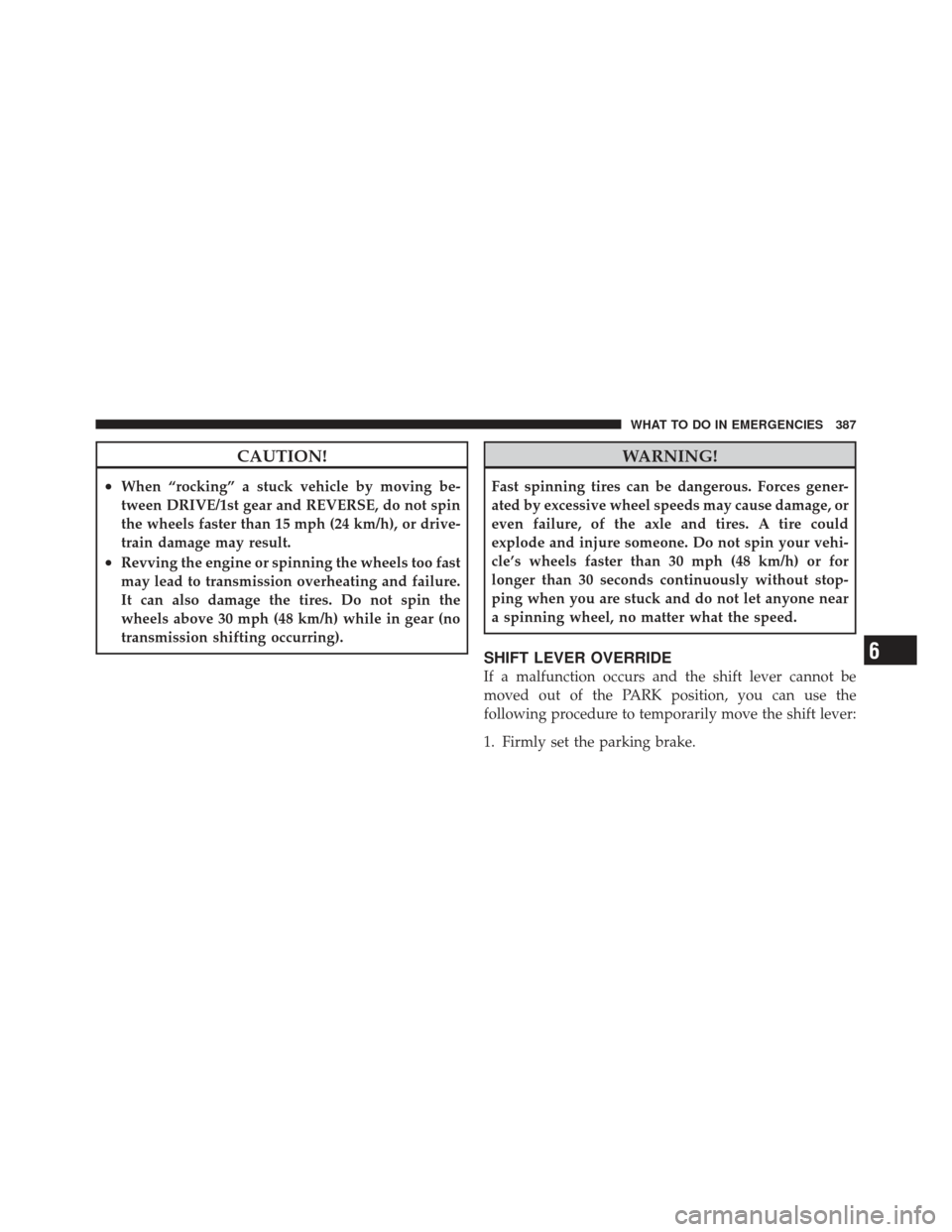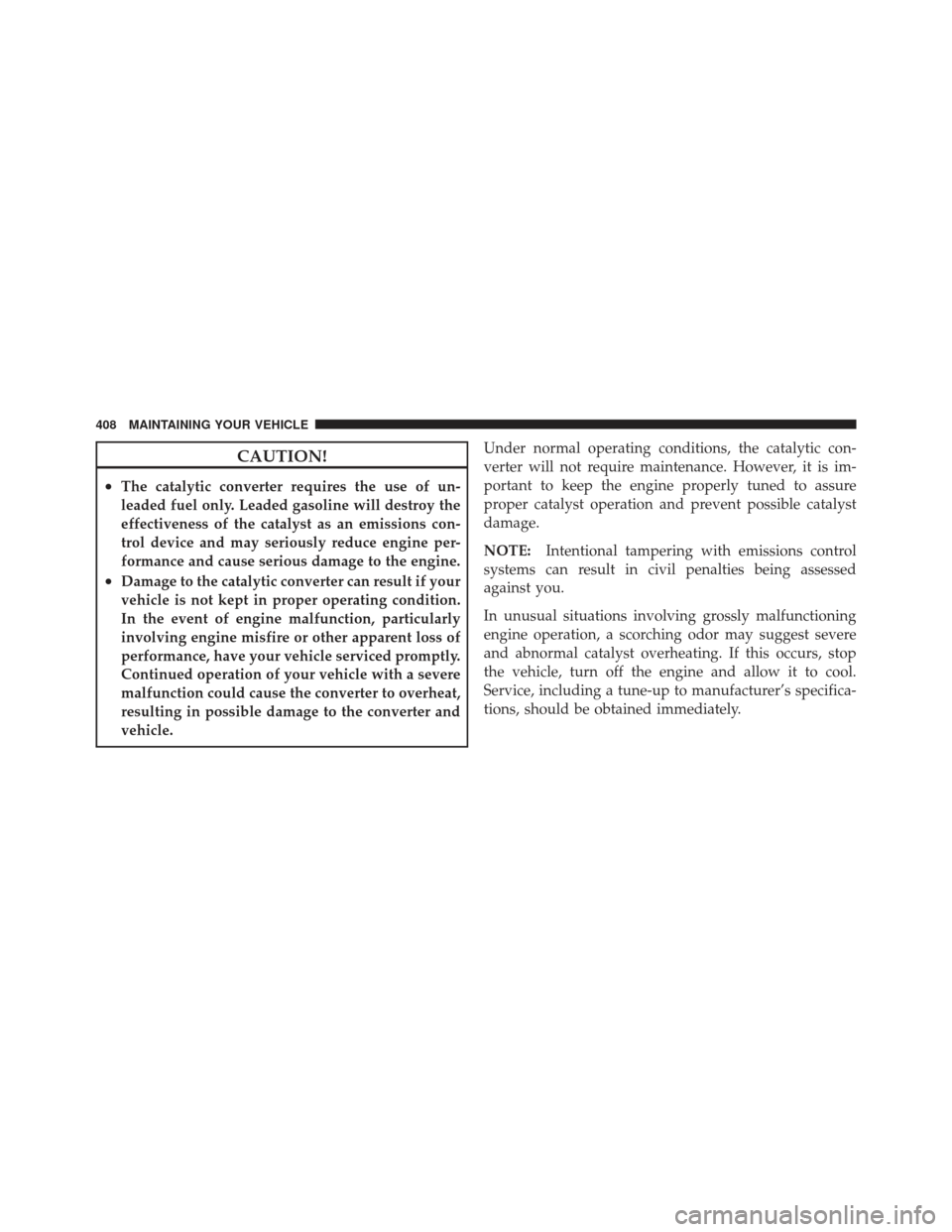Page 373 of 486
WHAT TO DO IN EMERGENCIES
CONTENTS
�Hazard Warning Flashers ................ 372
� If Your Engine Overheats ................ 372
� Automatic Transmission Overheating ....... 373
� Jacking And Tire Changing ............... 374
▫ Jack Location ....................... 374
▫ Spare Tire Stowage ................... 375
▫ Preparations For Jacking ............... 375
▫ Jacking Instructions ................... 376 �
Jump-Starting Procedures ................ 381
▫ Preparations For Jump-Start ............. 382
▫ Jump-Starting Procedure ............... 384
� Freeing A Stuck Vehicle ................. 386
� Shift Lever Override ................... 387
� Towing A Disabled Vehicle ............... 388
▫ With Ignition Key .................... 388
▫ Without The Ignition Key .............. 390
6
Page 374 of 486

HAZARD WARNING FLASHERS
The Hazard Warning flasher switch is located on the
instrument panel, below the radio.Press the switch to turn on the Hazard Warning
flasher. When the switch is activated, all directional
turn signals will flash on and off to warn oncoming
traffic of an emergency. Press the switch a second time to
turn off the Hazard Warning flashers.
This is an emergency warning system and it should not
be used when the vehicle is in motion. Use it when your
vehicle is disabled and it is creating a safety hazard for
other motorists.
When you must leave the vehicle to seek assistance, the
Hazard Warning flashers will continue to operate even
though the ignition is placed in the OFF position.
NOTE: With extended use the Hazard Warning flashers
may wear down your battery.
IF YOUR ENGINE OVERHEATS
In any of the following situations, you can reduce the
potential for overheating by taking the appropriate ac-
tion.
•On the highways — slow down.
•In city traffic — while stopped, place the transmission
in NEUTRAL, but do not increase engine idle speed.
NOTE: There are steps that you can take to slow down
an impending overheat condition:
•If your air conditioner (A/C) is on, turn it off. The A/C
system adds heat to the engine cooling system and
turning the A/C off can help remove this heat.
•You can also turn the temperature control to maximum
heat, the mode control to floor and the blower control
to high. This allows the heater core to act as a
supplement to the radiator and aids in removing heat
from the engine cooling system.
372 WHAT TO DO IN EMERGENCIES
Page 375 of 486

CAUTION!
Driving with a hot cooling system could damage
your vehicle. If the pointer rises to the H (red) mark,
the instrument cluster will sound a chime. When
safe, pull over and stop the vehicle with the engine at
idle. Turn off the air conditioning and wait until the
pointer drops back into the normal range. If the
pointer remains on the H (red) mark for more than a
minute, turn the engine off immediately and call for
service.
WARNING!
You or others can be badly burned by hot engine
coolant (antifreeze) or steam from your radiator. If
you see or hear steam coming from under the hood,
do not open the hood until the radiator has had time
to cool. Never try to open a cooling system pressure
cap when the radiator or coolant bottle is hot.
AUTOMATIC TRANSMISSION OVERHEATING
During sustained high speed driving or trailer towing up
long grades on hot days, the automatic transmission oil
may become too hot.If this happens, the transmission overheat in-
dicator light will come on, and the vehicle will
slow slightly until the automatic transmission
cools down enough to allow a return to the
requested speed. If the high speed is maintained, the
overheating may reoccur, as before, in a cyclic fashion.6
WHAT TO DO IN EMERGENCIES 373
Page 388 of 486

CAUTION!
Accessories that can be plugged into the vehicle
power outlets draw power from the vehicle’s battery,
even when not in use (i.e., cellular phones, etc.).
Eventually, if plugged in long enough, the vehicle’s
battery will discharge sufficiently to degrade battery
life and/or prevent the engine from starting.
FREEING A STUCK VEHICLE
If your vehicle becomes stuck in mud, sand or snow, it
can often be moved by a rocking motion. Turn your
steering wheel right and left to clear the area around the
front wheels. Then shift back and forth between DRIVE/
1st gear and REVERSE. Using minimal accelerator pedal
pressure to maintain the rocking motion, without spin-
ning the wheels, is most effective.
CAUTION!
Racing the engine or spinning the wheels may lead to
transmission overheating and failure. Allow the en-
gine to idle with the shift lever in NEUTRAL for at
least one minute after every five rocking-motion
cycles. This will minimize overheating and reduce
the risk of transmission failure during prolonged
efforts to free a stuck vehicle.
NOTE: If your vehicle is equipped with Traction Con-
trol or Electronic Stability Control (ESC), turn the system
OFF before attempting to “rock” the vehicle.
386 WHAT TO DO IN EMERGENCIES
Page 389 of 486

CAUTION!
•When “rocking” a stuck vehicle by moving be-
tween DRIVE/1st gear and REVERSE, do not spin
the wheels faster than 15 mph (24 km/h), or drive-
train damage may result.
•Revving the engine or spinning the wheels too fast
may lead to transmission overheating and failure.
It can also damage the tires. Do not spin the
wheels above 30 mph (48 km/h) while in gear (no
transmission shifting occurring).
WARNING!
Fast spinning tires can be dangerous. Forces gener-
ated by excessive wheel speeds may cause damage, or
even failure, of the axle and tires. A tire could
explode and injure someone. Do not spin your vehi-
cle’s wheels faster than 30 mph (48 km/h) or for
longer than 30 seconds continuously without stop-
ping when you are stuck and do not let anyone near
a spinning wheel, no matter what the speed.
SHIFT LEVER OVERRIDE
If a malfunction occurs and the shift lever cannot be
moved out of the PARK position, you can use the
following procedure to temporarily move the shift lever:
1. Firmly set the parking brake.
6
WHAT TO DO IN EMERGENCIES 387
Page 410 of 486

CAUTION!
•The catalytic converter requires the use of un-
leaded fuel only. Leaded gasoline will destroy the
effectiveness of the catalyst as an emissions con-
trol device and may seriously reduce engine per-
formance and cause serious damage to the engine.
•Damage to the catalytic converter can result if your
vehicle is not kept in proper operating condition.
In the event of engine malfunction, particularly
involving engine misfire or other apparent loss of
performance, have your vehicle serviced promptly.
Continued operation of your vehicle with a severe
malfunction could cause the converter to overheat,
resulting in possible damage to the converter and
vehicle.Under normal operating conditions, the catalytic con-
verter will not require maintenance. However, it is im-
portant to keep the engine properly tuned to assure
proper catalyst operation and prevent possible catalyst
damage.
NOTE:
Intentional tampering with emissions control
systems can result in civil penalties being assessed
against you.
In unusual situations involving grossly malfunctioning
engine operation, a scorching odor may suggest severe
and abnormal catalyst overheating. If this occurs, stop
the vehicle, turn off the engine and allow it to cool.
Service, including a tune-up to manufacturer’s specifica-
tions, should be obtained immediately.
408 MAINTAINING YOUR VEHICLE
Page 415 of 486

WARNING!
•The warning words “DO NOT OPEN HOT” on
the cooling system pressure cap are a safety pre-
caution. Never add engine coolant (antifreeze)
when the engine is overheated. Do not loosen or
remove the cap to cool an overheated engine. Heat
causes pressure to build up in the cooling system.
To prevent scalding or injury, do not remove the
pressure cap while the system is hot or under
pressure.
•Do not use a pressure cap other than the one
specified for your vehicle. Personal injury or en-
gine damage may result.
Disposal Of Used Engine Coolant
Used ethylene glycol-based engine coolant (antifreeze) is
a regulated substance requiring proper disposal. Check
with your local authorities to determine the disposalrules for your community. To prevent ingestion by ani-
mals or children do not store ethylene glycol-based
engine coolant (antifreeze) in open containers or allow it
to remain in puddles on the ground. If ingested by a child
or pet, seek emergency assistance immediately. Clean up
any ground spills immediately.
Coolant Level
The coolant bottle provides a quick visual method for
determining that the coolant level is adequate. With the
engine idling and warm to normal operating tempera-
ture, the level of the engine coolant (antifreeze) in the
bottle should be between the “ADD” and “FULL” lines
shown on the bottle.
The radiator normally remains completely full, so there is
no need to remove the radiator cap unless checking for
the coolant freeze point or replacing the engine coolant
(antifreeze). Advise your service attendant of this. As
7
MAINTAINING YOUR VEHICLE 413
Page 468 of 486

ABS (Anti-Lock Brake System).............. 312
Adding Engine Coolant (Antifreeze) .......... 411
Adding Fuel ........................... 354
Adding Washer Fluid ..................... 406
Additives, Fuel ......................... 352
Air Cleaner, Engine (Engine Air Cleaner Filter) . . . 402
Air Conditioner Maintenance ............... 404
Air Conditioning ........................ 275
Air Conditioning Controls ................. 275
Air Conditioning Filter .................... 286
Air Conditioning Refrigerant .............404,405
Air Conditioning System .............275,279,404
Air Conditioning, Operating Tips ............ 287
Air Pressure, Tires ....................... 331
Airbag .............................. 59,69
Airbag Deployment ....................... 70
Airbag Light ..................... 67,73,86,193
Airbag Maintenance ....................... 72
Airbag, Side ........................ 63,66,69Airbag, Window (Side Curtain)
...........64,66,69
Alarm Light ........................... 200
Alarm System (Security Alarm) ............... 17
Alterations/Modifications, Vehicle ............. 7
Antenna, Satellite Radio ................232,257
Anti-Lock Brake System (ABS) .............. 312
Anti-Lock Warning Light .................. 203
Anti-Theft Security Alarm (Theft Alarm) ........ 17
Antifreeze (Engine Coolant) ...........410,435,436
Capacities .......................... 435
Disposal ........................... 413
Appearance Care ........................ 419
Assistance Towing ....................... 111
Automatic Dimming Mirror ................. 94
Automatic Door Locks ................... 29,30
Automatic Temperature Control (ATC) ......... 279
Automatic Transaxle ..............12,293,373,417
Fluid Level Check .................... 418
Overheating ........................ 373
466 INDEX